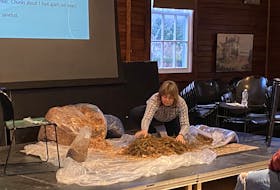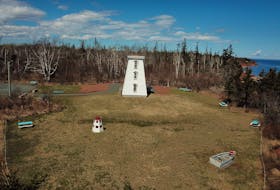By Sara Connors
The SaltWire Network
It was a canoe trip that almost resulted in its partakers being air evacuated - three times, to be exact.
Despite one member contracting a debilitating case of suspected dysentery, another breaking his tooth to the pulp, and rapids almost folding one of the group’s two canoes in half, four outdoor enthusiasts persevered, travelling through Labrador’s remote wilderness on an “extreme” canoe trip this past summer.
“We had some challenging days we had to get through,” said Alex Traynor, one of the paddlers, who is from Ontario.
“(I don’t know) how many times we would look at each other and shake our heads over how ridiculous the task at hand was.”

Exploring undiscovered areas
Traynor — along with childhood friend Noah Booth, who now lives in Halifax, N.S., and experienced expeditioners Dave Greene, also from Nova Scotia, and Chris Giard of Massachusetts — paddled 670 kilometres over 35 days, from the Menihek Hydroelectric Generating Station in Labrador West to the region’s northernmost community of Nain.
While even the most fervent outdoor enthusiasts might balk at spending over a month in Labrador’s isolated interior, this type of trip was something the group had tried before.
Greene and Giard completed a 56-day trip across the Northwest Territories last summer, and Traynor and Booth are passionate canoe and camping enthusiasts. Together, the pair manage Northern Scavenger, an outdoor adventure Youtube channel with almost 9,000 subscribers.
Booth, a geologist, pitched Labrador as a paddling destination after spending time working in the region on and off for the last five years.
Largely ignored for its neighboring island, Booth said Labrador’s desolation and uncharted landscape made it appealing.
“It’s known as the ‘Big Land’ for a reason. It’s full of wild lakes, wild rivers, and wilderness that is rarely travelled because of how rugged the terrain is and all the flies.”
While Traynor admits he “never had a real dream to go to Labrador,” he was interested in exploring its undiscovered badlands.
After convincing Greene and Giard to join, the group spent an entire year painstakingly planning for the trip, which Booth said consisted of “a lot of staring at maps.”

Unforgettable experience
After arriving in Menihek, the group covered approximately 20 kilometres a day, crossing various types of terrains and ecosystems, such as the subarctic, boreal, barren lands and what Booth describes as “coastal rainforest.”
Traynor said getting to witness scenery that few — if any — others have laid eyes on made the trip an unforgettable experience.
“The times we were getting to paddle through (mountains) were pretty incredible, knowing that no one had seen these places. There were points we were coming to waterfalls that, guaranteed, would be in a national park if they were closer.”
The excursion, however, was not without its challenges.
It rained for the first 28 days of the trip, and Labrador’s plentiful blackflies caused the group to be constantly covered in bug bites.
“It really is a test of character,” said Booth.
“You’re damp all day. The bugs really distract you when you’re portaging, and you’re trying to balance on slippery rocks and dragging the canoe up and down rapids. You’re trying to focus, but at the same time, you’re inhaling blackflies.”
Physical and equipment problems also almost resulted in a handful of air evacuations.
The trip was almost cut short early on after Booth likely contracted dysentery after drinking water from a pond he suspects was contaminated with geese droppings, though he later recovered.
On day 21, Greene broke his tooth to the pulp, which, if infected, could have led to serious problems due to the teeth’s proximity to the brain.
The next day, Traynor’s canoe almost folded in half after getting pinned during a rocky rapid crossing. All four men had to work together to rescue the canoe and pop it back into place.
While some days could be extremely stressful at times, Traynor said these experiences also bonded the group.
“At the end of the day, you’re just sitting around the campfire at night while you’re drying your clothes, and you can find a way to laugh at what you did (that day)," he said. "I don’t think there’s many people that can say (they did what we did).”

Extreme tourism
Carol Ann Carter, manager of Tourism for the Government of Newfoundland and Labrador, said while she thinks an “extreme” canoe trip is a unique way of exploring Labrador’s rugged landscape, she doesn’t see it being a foreseeable way of attracting tourists.
“I’m not aware of any operator that would offer that type of excursion. Usually, people only go canoeing for a few hours.”
But while Labrador might not be an ideal tourist attraction for most, Booth said for “extreme” outdoor enthusiasts, it’s “the best place to go.”
“It’s so vast, there’s so many different places you could travel. If you don’t mind a couple of bug bites, some rain, and some hard work, it really is a paradise.”








